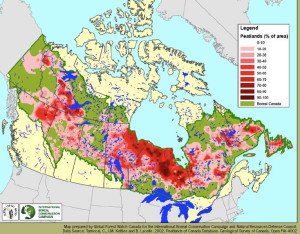We are so blessed in Canada to have such vast areas of unspoiled wilderness, and I love the idea of keeping as much as possible undisturbed. I joined CPAWS Wildlands League last November because I want to help make that happen. I recognize there are increasing demands to tap the country’s resource wealth, and my hope is that organizations like CPAWS Wildlands League will help protect our country’s great ecological treasures while at the same time making sure development plans don’t harm ecosystems and respect local communities. My mandate as a Major Gifts Officer is to share information with prospective donors and encourage their support of our projects.
There are so many stories to tell and exciting facts to share, but my favourite is the Boreal Forest. Before I began working here, I had no idea that the largest intact stretch of undisturbed forest left in the world is in Canada, and I was astonished by the fact that the forests and wetlands of Ontario’s Far North store more carbon than the entire Amazon basin. They help regulate the planet’s climate.
The Canadian Boreal Initiative states in its aptly named report, The Carbon the World Forgot, that: “boreal forest regions store more carbon than any other terrestrial ecosystem, almost twice as much per acre as tropical forests.” It continues: “The carbon stored below ground in the boreal forest dwarfs the surface carbon in the trees, a fact that has not always been fully appreciated.” I had no idea.
And did you know that Ontario’s Hudson Bay Lowland bordering Hudson and James Bays is the second largest peatland area in the world after Siberia? I didn’t. Did you know that these wetlands help cool the planet? Unlike trees and other plants that absorb carbon dioxide and release oxygen back into the atmosphere, carbon and a variety of greenhouse gases are stored in the peat. The permafrost and water covering the peatlands is what maintains the carbon “sink” and keeps the gases trapped. Disruptive industrial activity could disturb this carbon vault and release climate pollution into the atmosphere. I am reminded of the unintended consequences of opening Pandora’s Box. We are only just beginning to understand the role of natural ecosystems in helping to regulate climate and cool the planet. Irresponsible development could lift the lid and accelerate the release of damaging global warming pollution.

We should be shouting at the top of our lungs about the importance of the Boreal Forest!! For decades we have been hearing that the destruction of the Amazon rain forest was the biggest threat to climate change. It’s time to start focusing attention closer to home.
So what can we do? Engage the imagination of fellow Canadians. Stress the global significance of conserving Canada’s Boreal Forest. Explain the risks of ill planned and rampant industrial development from a climate change perspective. Ensure industry and government leaders recognize the importance of keeping some of our natural resources undisturbed and carbon stores deep in the ground.
I’m learning so much. I have so many stories to tell and look forward to sharing them with you.
By Mary Jane Wood, Major Gifts Officer, CPAWS Wildlands League

